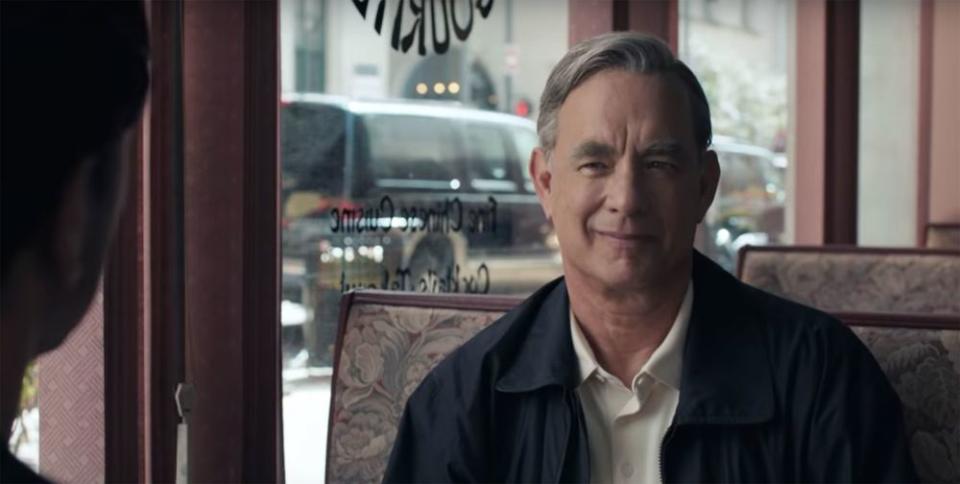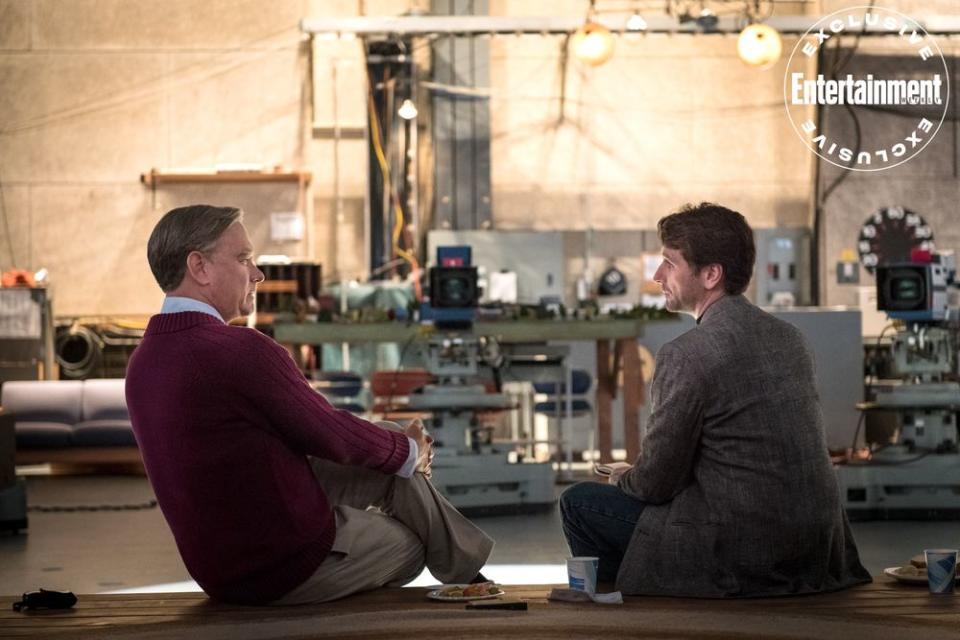A Beautiful Day in the Neighborhood writers break down Tom Hanks' powerful minute of silence scene

Warning: This post contains light spoilers for A Beautiful Day in the Neighborhood.
Some movie moments are so powerful, even their makers can’t get through them without crying.
“We got emotional on the set every day. There was a lot [of] hand-holding and gathering around the monitors, just quivering with tears,” A Beautiful Day in the Neighborhood cowriter Noah Harpster tells EW of working on Marielle Heller’s Mister Rogers-themed drama, an Oscar-worthy achievement he and writing partner Micah Fitzerman-Blue spent 10 years developing.
Of the many tear-jerking moments, however, the most powerful (and pivotal) comes approximately halfway through the film, when, in a bold move, Fitzerman-Blue and Harpster’s script directs viewers to leave the world of the film and reflect on their own lives. While seated opposite his latest profile subject (Tom Hanks as Fred Rogers) at a Chinese restaurant in Pittsburgh, Matthew Rhys‘ Lloyd Vogel — a cynical Esquire magazine writer grappling with deep-seated daddy issues — cracks under the therapeutic pressures of his latest interviewee, who asks him to accept his decades-old feelings of rage and frustration as byproducts of an absent father whose actions, while painful, inadvertently taught him the vital difference between right and wrong, and have helped make him into the man he is.
Then, it happens: As the bustle of clanking plates and lunchtime chatter lessens around them, Rogers asks Vogel to take a minute of silence to consider the people who’ve loved him into being. For the next 60 seconds, Vogel and Rogers sit in quietude while the camera pans around the restaurant (diner patrons include Fred Rogers’ real-life spouse, Joanne, and David Newell, the actor who played Mr. McFeely on Mister Rogers’ Neighborhood) before training on Hanks’ face as he shifts his gaze from Vogel to the audience in the theater, asking us to consider the most important people in our lives as well.
For our recurring Making a Scene feature, EW recently caught up with the scene’s writers to discuss the idea behind the profound moment and what it was like watching Heller, Hanks, and Rhys bring to life the most precious piece of their 10-year labor of love.

The sentiment
“From the beginning, this project was a chance to have Fred Rogers talk to adults in the way that he spoke to children,” Harpster says of the film’s structure, which stages the film’s central story like an episode of the original Neighborhood show — complete with Hanks’ intermittent to-camera narration from the set of the show. Both writers say witnessing grown adults weep while Rogers attempted the reflective bit (once at the 1997 Emmys and later during his 2002 Dartmouth commencement address) inspired its placement in the film. “That was our hope with this entire movie: to get people in the entire audience to think about their own lives and their own experiences and childhood in the way that Fred was able to.”
“Your instinct as a parent, when your kid is crying, is to fill the discomfort with noise, [and say] ‘Don’t cry! It’s going to be ok!’ [and] distract them out of their feelings,” Fitzerman-Blue adds. “What [Rogers] was so committed to was allowing parents to make it safe for their children to have feelings. We wanted the movie to recreate that feeling, to have Fred Rogers hold space for you.”
The structure
The scene epitomizes Harpster and Fitzerman-Blue’s unique approach to translating the Rogers legacy to the big screen, but figuring out how to incorporate the moment of silence into the fabric of their already emotionally expansive story meant toying with structure and timing. Both writers say initial versions of the script always had the scene taking place inside the Chinese restaurant (it’s a scene that begs for softness of the heart, as Rogers reveals to Vogel he’s a vegetarian because he couldn’t “eat anything with a mother”), though it shifted locations after redrafts before landing in its original spot.
“This is a movie about someone learning how to forgive and crack open their heart, if only a little bit, to create a real change in their life,” Fitzerman-Blue explains, adding that the scene works at the film’s midpoint because it represents a turning point for Vogel’s softening heart. “Fred finally has chipped away the cynicism and Lloyd becomes a convert. He’s willing to listen to Fred in a way that he wasn’t in the first half of the movie.”

The stare
One thing that never changed about the scene, the writers say, was the moment Rogers turns to the camera and breaks the fourth wall — a move they admit could have been “schmaltzy” in the hands of a lesser director than Heller.
“Over the years, people would read the script and say, ‘You can’t do that. What are you doing!?’” Harpster remembers. “When Mari read the script, she said, ‘First off, we’re doing the minute of silence looking right in the camera!’ Like, all of these things we’d questioned over the years, she just got.”
The set
After 10 years of finessing their work, Harpster and Fitzerman-Blue wanted to be present on the Pittsburgh-based set while Heller filmed the scene, and it ultimately came to mean more to them than simply witnessing the translation of their written word to moving image, but rather a validation of the project’s soul by the people who knew Rogers best.
“We invited everyone Noah and I spent years trying as best we could to convince them to let us make this movie,” Fitzerman-Blue remembers, referencing Rogers’ family and friends who make cameos in the scene — including his widow, Joanne, and real-life business partner Bill Isler (played by Enrico Colantoni in the film). “The movie behind this moment is the softening of the real Bill Isler, who, when we first came [to Pittsburgh] almost eight years ago, said there will never ever be a movie about Fred Rogers, but ‘you guys seem nice, so, I’ll keep talking to you.'”
He continues: “To take it from that point to this moment at the Chinese restaurant with Joanne [and] all these people who had been the keepers of the flame, it was its own climax that was happening for us. It was the personal fulfillment of a dream we had to make this movie, not on our own, but in partnership with Fred Rogers’ family, his estate, and everyone who was part of the show.”
A Beautiful Day in the Neighborhood is now playing in theaters nationwide.
Related content:

